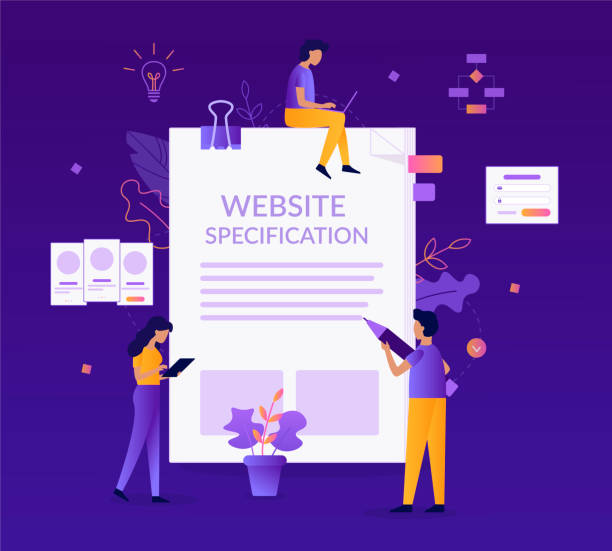The Dawn of Responsive Design and Its Importance

In today’s fast-paced world, where internet access through various devices such as smartphones, tablets, laptops, and large home displays has become the norm, Responsive Web Design has become an undeniable necessity.
This advanced approach in web design ensures that your website automatically and intelligently adapts to the dimensions and resolution of every user’s screen, whether small or large, providing the best possible user experience.
The importance of #Responsive_Web_Design goes beyond mere aesthetics; this approach directly impacts #User_Experience, #SEO (Search Engine Optimization), and Conversion Rate.
In the past, a separate version of the website was designed for each device, which was not only costly but also difficult to maintain.
With the emergence of the responsive design concept by Ethan Marcotte in 2010, this problem was fundamentally solved.
The main goal of this method is to create a seamless and optimized web experience for all users, regardless of the device they use.
This not only increases content accessibility but also helps businesses establish a stronger and more effective online presence and better engage their customers.
Did you know that a weak corporate website takes many opportunities from you daily? Solve this problem forever with professional corporate website design by Rasavab!
✅ Create a powerful and trustworthy image for your brand
✅ Attract new customers purposefully and increase sales
⚡ [Get free website design consultation]
The Pillars of Responsive Design: Technical Principles and Techniques

For successful implementation of Responsive Web Design, understanding its three main pillars is crucial: Media Queries, Flexible Grids, and Flexible Images.
Media Queries are the beating heart of responsive design, allowing developers to apply different CSS rules based on device characteristics such as screen width, height, orientation, and resolution.
For instance, you can define how an element should display on smaller screens and what changes it should undergo on larger screens.
CSS and HTML are the two main tools for implementing these pillars.
Flexible grids, typically designed using relative units like percentages (%) or ’em’ units instead of fixed pixel units, ensure that the website layout is displayed flawlessly and proportionally across different screen sizes.
This method allows page elements to naturally rearrange instead of breaking or disappearing.
Flexible images, using the `max-width: 100%` property in CSS, ensure that images never exceed their container and their size is adjusted proportionally to the available space, which is crucial for preventing unwanted horizontal scrolling and improving site performance.
The combination of these three elements creates a strong foundation for any responsive website and allows for an optimal experience on any device.
These principles are the cornerstone of any professional Responsive Web Design.
Endless Benefits of User Experience and SEO in Responsive Design

Investing in Responsive Web Design is not just a smart choice for user experience (UX), but also has a significant impact on search engine optimization (SEO).
From a user’s perspective, a responsive website provides a seamless and enjoyable experience.
Users don’t need to zoom, horizontal scroll, or tolerate cluttered layouts, which in turn helps reduce bounce rate and increase time spent on the site.
When users have a good experience on your site, they are more likely to return and become loyal customers.
From an SEO perspective, Google officially recommends responsive design as the best practice for mobile websites.
The reason is simple: a single URL for all devices.
This means there’s no longer a need to maintain two separate versions of the website (one for desktop and one for mobile), which eliminates complexities related to duplicate content and link building.
Google can easily crawl and index your website and direct mobile and desktop traffic to a single URL.
This, in turn, improves your ranking in search results, especially in mobile searches, which now constitute a major portion of internet traffic.
A website with Responsive Web Design has better performance and faster loading speed on mobile devices, which are also important ranking factors in Google.
Overall, responsive design not only helps improve user interaction but is also a powerful strategy for increasing online visibility and SEO success.
| Benefit Category | Description | Impact |
|---|---|---|
| User Experience (UX) | Automatic adaptation to all devices and screen sizes | Increased user satisfaction, reduced bounce rate |
| Search Engine Optimization (SEO) | Single URL for all devices, Google approved | Improved search ranking, increased traffic |
| Maintenance and Management | Need to maintain a single codebase instead of multiple versions | Reduced costs and maintenance time |
| Accessibility | Providing content for a wide range of users and devices | Expanded target audience |
Common Challenges and Smart Solutions in Responsive Implementation

Although Responsive Web Design offers numerous benefits, its implementation is not without challenges and requires a smart approach.
One of the biggest challenges is performance issues.
Often, responsive websites become heavier due to loading all assets (images, CSS, JavaScript) for all screen sizes, which can lead to slow loading speeds, especially on mobile devices with slower internet connections.
The solution to this problem is to use techniques such as Lazy Loading for images and videos, image optimization (using modern formats like WebP and adjusting appropriate sizes for different devices), and code compression (CSS and JavaScript).
Another challenge is managing complex content and layouts.
In some cases, content and design elements suitable for desktops may occupy too much space or not display well on smaller mobile screens.
This highlights the need for a “mobile-first” mindset, meaning starting the design for small devices first and then developing it for larger screens.
This approach ensures that essential and primary content is always accessible and the user experience is maintained.
Furthermore, support for older browsers can be a challenge, as some CSS3 features used in responsive design may not be supported in them.
Using Polyfills and Fallbacks can solve this issue.
Finally, testing and debugging across multiple devices and different browsers can be time-consuming, but browser developer tools and online simulators have made this process easier.
By observing these points, an efficient and flawless Responsive Web Design can be achieved.
Tired of your company’s website not being seen as it should be, losing potential customers? With Rasavab, solve the problem of not attracting potential customers through your website forever!
✅ Increase brand credibility and gain customer trust
✅ Attract targeted sales leads
⚡ Contact us now for a free website design consultation!
Designers’ Toolkit: Popular Frameworks and Libraries

Implementing Responsive Web Design from scratch can be time-consuming and complex, which is why many developers turn to CSS frameworks and libraries.
These tools provide a collection of pre-defined codes and components that accelerate the process of building responsive websites and give them structure.
Bootstrap is undoubtedly one of the most popular and widely used frameworks in this field.
With a powerful Grid System, ready-to-use UI components (like buttons, forms, navigations), and JavaScript plugins, Bootstrap allows developers to quickly build modern and responsive websites.
Its ease of use and large user community make Bootstrap an excellent choice for various projects.
Foundation is another powerful framework known for its flexibility and focus on a mobile-first approach.
Foundation gives developers more control over design and is a suitable choice for projects requiring deeper customization.
Additionally, there are lighter and more specialized frameworks, such as Bulma, which is built purely on CSS and is appealing to those who do not want a dependency on JavaScript.
Alongside frameworks, some developers prefer to work with pure CSS without a framework to have complete control over their code and avoid loading extra code.
This method requires deeper knowledge of media queries and flexbox/grid, but ultimately can lead to more optimized and customized code.
The choice of framework or approach depends on the project scale, timeline, and development team preferences, but all these tools contribute to a common goal: building effective Responsive Web Design.
Testing and Debugging Responsive Websites: A Comprehensive Approach

After implementing Responsive Web Design, the critical phase of testing and debugging arrives.
This stage ensures that your website displays correctly and performs optimally across all devices and browsers.
Browser Developer Tools, such as Inspect Element in Chrome or Firefox, are among the most powerful testing tools.
These tools allow you to simulate your website on various screen sizes, inspect elements, and observe CSS changes live.
While these simulators are not perfectly accurate, they provide a very good initial insight.
Testing on real devices is of paramount importance.
No simulation can fully replicate the user experience on a real device, as there are differences in browser rendering, touch performance, and hardware.
Therefore, it is recommended to test your website on at least a few popular mobile phones and tablets with different operating systems (iOS and Android).
Tools like BrowserStack or CrossBrowserTesting also provide the ability to test your website across hundreds of different device and browser combinations in the cloud, which is very useful for large teams and complex projects.
Furthermore, speed measurement tools such as Google PageSpeed Insights and GTmetrix can help you identify performance issues and offer suggestions for improving website loading speed.
With a comprehensive approach to testing and debugging, you can ensure that your Responsive Web Design is flawless and provides an optimal user experience for everyone.
New Horizons in Responsive Web Design: A Future Full of Innovation

The world of Responsive Web Design is constantly evolving, and with the advent of new technologies, it presents new horizons for web designers and developers.
One of the most important future trends is the advancement of Progressive Web Apps (PWAs).
PWAs, by combining the best features of web and native applications, offer a mobile-app-like experience through the browser, including home screen installation, offline access, and push notifications.
This approach blurs the line between websites and applications, consequently ushering Responsive Web Design into a new phase of interactive and functional capabilities.
In addition to PWAs, new CSS modules like CSS Grid Layout and Flexbox are increasingly being used to create more complex and flexible layouts.
These modules provide powerful tools for precise control over the position and size of elements in responsive layouts, reducing the need for CSS hacks or heavy frameworks.
Container Queries are also under development, which will allow designers to adjust element behavior based on their parent container’s size, not just the overall viewport size.
This feature will revolutionize how independent and reusable components are designed, further increasing the dynamism of Responsive Web Design.
Also, Accelerated Mobile Pages (AMP) technology continues to be relevant for ultra-fast content loading on mobile, although it faces some criticism in certain cases.
These advancements indicate a bright future full of innovation for Responsive Web Design, aiming to provide an even better and faster user experience.
| Feature | Current Technology | Future Trends & Emerging Technologies |
|---|---|---|
| Layout Management | Media Queries based on Viewport | Container Queries, Advanced CSS Grid & Flexbox |
| Mobile User Experience | Standard Responsive Website | Progressive Web Apps (PWAs), WebAssembly |
| Performance and Speed | Image and regular code optimization | Smart Image CDNs, Server-Side Rendering (SSR) |
| Interactivity | Standard Javascript | Web Components, WebXR (Augmented and Virtual Reality) |
Successful Examples and Lessons Learned from Top Designs

Examining successful examples of Responsive Web Design can be inspiring and a good guide for developers.
Many large and reputable global brands have been pioneers in implementing responsive designs and have taught valuable lessons to the web industry.
For example, the New York Times website was one of the first major publications to adopt a fully responsive approach.
Their design clearly shows how a large volume of text and image content can be organized to be readable and accessible on any screen size, without losing user experience.
This website uses a fluid grid structure and flexible images for optimal display of articles on different devices.
Another prominent example is large retail websites like Amazon or Walmart, whose responsive design allows users to easily search, view, and purchase products, whether on desktop or mobile.
They have well understood the importance of simplicity in navigation and an easy checkout process in their mobile-first design.
Lessons learned from these examples include: Content Prioritization for display on small screens, image and performance optimization for fast loading speeds, and continuous testing on various devices.
Furthermore, attention to small UI details such as button and link sizes for finger touch is crucial for the success of Responsive Web Design.
Inspired by these top examples and lessons learned, websites can be built that are not only beautiful but also effectively meet user needs in any environment and contribute to business goals.
Are you losing business opportunities because of an outdated website? With Rasavab, solve the problem of not attracting potential customers through your website forever!
✅ Attract more high-quality leads
✅ Increase brand credibility in the eyes of customers
⚡ Get a free corporate website design consultation now!
Economic Analysis of Investing in Responsive Website Design

Investing in Responsive Web Design is more than a technical decision; it is a strategic and economic decision for any modern business.
At first glance, the initial cost of designing or redesigning a responsive website might seem higher than building separate desktop and mobile versions.
However, with a deeper analysis, it becomes clear that the Return on Investment (ROI) of responsive design is significantly higher in the long run.
One of the biggest savings is in maintenance and management costs.
By having a single codebase, content and feature updates are only needed once, significantly reducing the time and resources required for website management.
This is especially efficient for rapidly growing businesses that need frequent updates.
Furthermore, the improved SEO that results from a responsive website means increased organic traffic and, consequently, less need for significant spending on paid advertising.
A better ranking in search results translates to greater visibility and attracting more potential customers, which directly impacts revenue.
Increased conversion rates are another important factor.
When users have a good experience on your website, they are more likely to take the desired action (purchase, registration, contact).
This increase in conversion rate can directly lead to higher sales and revenue.
Finally, reduced bounce rate and increased user time on site, in addition to positively impacting SEO, help build stronger connections with customers and foster their long-term loyalty.
Therefore, Responsive Web Design is not just an investment in technology, but a smart investment in the future and sustainability of your business.
Conclusion and a Bright Future for Responsive Web

As thoroughly discussed throughout this article, Responsive Web Design is no longer a luxury option but a fundamental necessity for any successful online presence.
In an era where users access the web through diverse devices and platforms, providing a seamless and optimized user experience is key to attracting and retaining audiences.
This approach not only significantly improves user experience, site speed, and SEO, but also helps reduce maintenance costs and increase conversion rates in the long run.
By understanding core principles such as media queries, flexible grids, and fluid images, the foundations of a responsive website can be laid.
Overcoming challenges like performance and compatibility with older browsers is also possible by employing optimization techniques and using appropriate tools.
Frameworks like Bootstrap and Foundation have smoothed the implementation path, while continuous testing and debugging on real devices ensure final quality.
The future of Responsive Web Design appears brighter and more dynamic than ever with innovations like PWAs and advanced CSS modules such as Container Queries.
These developments provide designers with more powerful tools to create unparalleled web experiences.
For any business and individual looking to maximize their online presence, Responsive Web Design is an essential investment whose results will yield significant returns over time.
By embracing this approach and staying up-to-date with the latest trends and technologies, you can ensure that your website remains relevant and efficient in the future.
Frequently Asked Questions
| Question | Answer |
|---|---|
| What is Responsive Web Design? | A method of website design that ensures the website displays well and provides a suitable user experience across various display sizes and devices (such as mobile, tablet, desktop). |
| Why is Responsive Design important? | Improved user experience, better SEO (Google prefers responsive sites), saving time and cost (no need to build a separate site for mobile). |
| What are the main techniques in Responsive Design? | Using flexible grids and layouts (Fluid Grid), flexible images and media, and using Media Queries in CSS. |
| What are Media Queries in Responsive Design? | A part of CSS3 that allows you to apply different styles based on the characteristics of the device on which the website is displayed (such as screen width, resolution, media type). |
| What are the benefits of using Responsive Design? | Access to more users (especially mobile), improved user engagement rate, reduced maintenance costs (one site for all devices), and improved Conversion Rate. |
And other services of Rasavab Advertising Agency in the field of advertising
Smart Content Strategy: An innovative service for improving SEO ranking through marketing automation.
Smart Sales Automation: A fast and efficient solution for user interaction focusing on attractive UI design.
Smart Custom Software: A creative platform for improving customer acquisition with Google Ads management.
Smart Direct Marketing: A dedicated service for campaign management growth based on intelligent data analysis.
Smart Sales Automation: An effective tool for increasing click-through rates with the help of real data.
And over hundreds of other services in the field of internet advertising, advertising consulting, and organizational solutions
Internet Advertising | Advertising Strategy | Advertorials
Resources
Comprehensive Guide to Responsive Design
Importance of Responsive Website Design in SEO
New Trends in Responsive Design
Mobile-First Design and the Future of Web
? Are you ready to transform your business in the digital space? Rasavab Afarin Digital Marketing Agency paves your path to success by offering innovative and comprehensive solutions including professional SEO, strategic social media management, and Responsive Website Design.
📍 Tehran, Mirdamad Street, next to Central Bank, Southern Kazeroun Alley, Ramin Alley, No. 6




